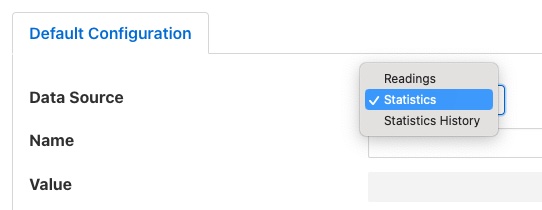Sustained Threshold Rule¶
The sustained threshold rule is used to detect the value of a data point within an asset exceeds above or falls below a specified threshold for a defined duration.
This rule is useful for ensuring that the threshold is crossed and maintained for a minimum time before triggering a notification or action.
Key Features:
Threshold Value: The rule triggers only when the data point value crosses a defined threshold for a specific amount of time.
Time Element: The threshold must be crossed for a continuous time period (in seconds) before the rule is activated.
Contiguous Time: The threshold crossing time must be contiguous. If the value crosses back over the threshold (e.g., goes below or above it) before the configured time elapses, the rule will reset, and no action will be triggered.
The configuration of the rule allows the threshold value and time to be set, the operation and the datapoint used to trigger the rule.
|
Data Source: The source of the data used for the rule evaluation. This may be one of Readings, Statistics or Statistics History. See details below.
Name: The name of the asset or statistics that is tested by the rule.
Value: The name of the datapoint in the asset used for the test. This is only required if the Data Source above is set to Readings.
Condition: The condition that is being tested, this may be one of >, >=, <= or <.
Trigger value: The threshold value that the data point must exceed or fall below.
Evaluation data: Select if the data evaluate is a single value or a window of values.
Window evaluation: Only valid if evaluation data is set to Window. This determines if the value used in the rule evaluation is the average, minimum or maximum over the duration of the window.
Time window: Only valid if evaluation data is set to Window. This determines the time span (in seconds) of the window.
Threshold time: The length of time (in seconds) that the threshold must be exceeded before the rule is triggered.
Data Source¶
The rule may be used to test the values of the data that is ingested by south services within FogLAMP or the statistics that FogLAMP itself creates.
When the rule examines a reading in the FogLAMP data stream it must be given the name of the asset to observe and the name of the data point within that asset. The data points within the asset should contain numeric data.
When observing a statistic there are two choices that can be made, to monitor the raw statistics value, which is a simple count, or to examine the statistic history. The value received by the threshold rule for a statistic is the increment that is added to the statistic and not the absolute value of the statistics.
The statistic history is the value seen plotted in the dashboard graphs and shows the change in the statistic value over a defined period. By default the period is 15 seconds, however this is configurable. In the case of statistics all that is required is the name of the statistic to monitor, there is no associated data point name as each statistic is a single value.
Example Use Case
Asset Name: X
Datapoint Name: Y
Condition: Greater than
Trigger Value: 100
Threshold Time: 30 seconds
In this case, the rule will only trigger if Data Point Y of Asset X exceeds 100 for a continuous 30 seconds. If the value exceeds 100 for 5 seconds, falls below 100 for 15 seconds, and then exceeds 100 again for another 5 seconds, the rule will not trigger, as the time exceeding 100 was not contiguous for 30 seconds.

